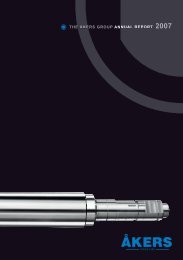CAEF Roll failures manual - The Åkers Group
CAEF Roll failures manual - The Åkers Group
CAEF Roll failures manual - The Åkers Group
Create successful ePaper yourself
Turn your PDF publications into a flip-book with our unique Google optimized e-Paper software.
5.4 Strip Edge Wear<br />
5.4.1 Description<br />
Circumferential wavelike scratch grooves appear on the barrel surface coinciding with the<br />
strip edge. <strong>The</strong> extent will depend upon the variation in strip widths rolled before a roll<br />
change. This appearance is typically observed on work rolls from the early finishing<br />
stands.<br />
5.4.2 Origin<br />
This feature is caused by increased resistance<br />
to deformation of the strip edge combined<br />
with high reduction rates in the early finishing<br />
stands. If the strip edge is considerably colder<br />
than the centre and if hard scale is present on<br />
the strip edge then higher specific load causes<br />
increased localised wear on the roll surface.<br />
This is more prevalent when rolling stainless<br />
steels with highly alloyed roll grades.<br />
This is a mill related phenomenon.<br />
5.4.3 Remedy<br />
Minimize temperature differences at the strip edges by strip edge heating, short delays,<br />
or use of a coil box or insulating hood prior to the finishing stands.<br />
Generally, in spite of rather high overall wear, ICDP rolls show more homogenous surface<br />
deterioration in case of stainless steel rolling compared to other roll grades.<br />
25<br />
Section 5 SURFACE CONDITION IN ROLLING




